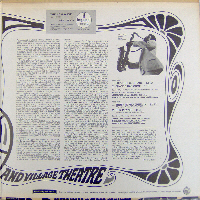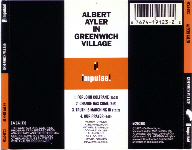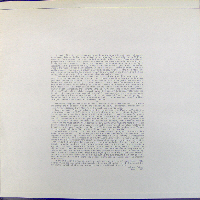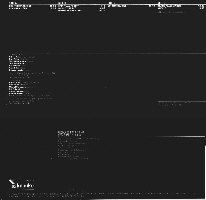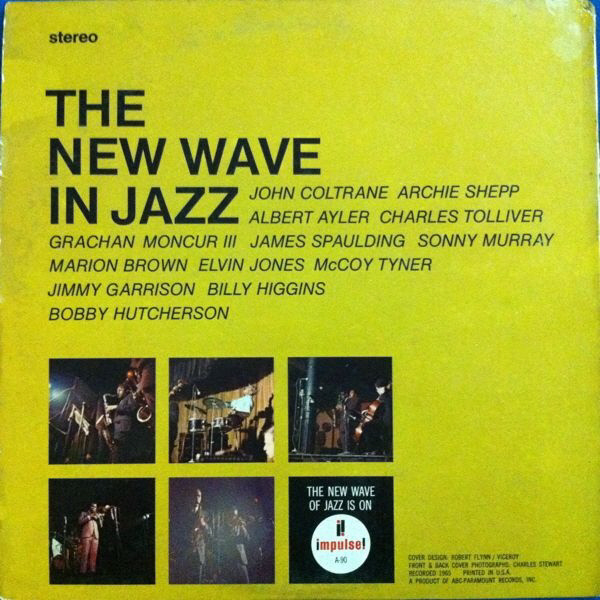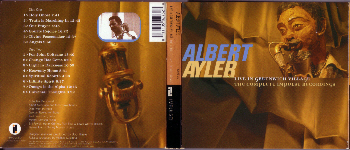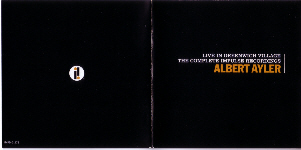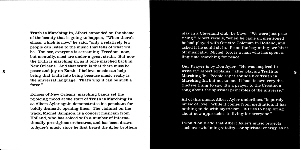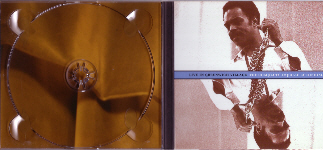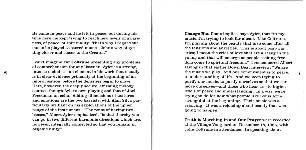|
Sleevenotes
Amiri Baraka (Leroi Jones) organised the concert at the Village Gate which provided the music for The New Wave in Jazz and he supplied the sleevenotes. He reprinted the sleevenotes in his 1968 collection of essays, Black Music:
New Black Music: A Concert in Benefit
of The Black Arts Repertory
Theatre/School Live
New Wave in Jazz (New Black Music)* (Impulse A-90). Recorded “live” at Village Gate, New York City, March 28, 1965.
(1)
1. “Nature Boy” (John Coltrane, tenor; Jimmy Garrison, bass; Elvin Jones, drums; McCoy Tyner, piano)
2. “Holy Ghost” (Albert Ayler, tenor sax; Joel Freedman, cello; Lewis Worrell, bass; Donald Ayler, trumpet; Sonny Murray, drums)
3. “Blue Free” (Grachun Moncur, trombone; Bill Harris, drums; Cecil McBee, bass; Bobby Hutcherson, vibraphone)
(2)
1. “Hambone” (Archie Shepp, tenor sax; Reggie Johnson, bass; Virgil Jones, trombone; Marion Brown, alto sax; Roger Blank, drums; Fred Pirtle, baritone sax; Ashley Fennell, trumpet)
2. “Brilliant Corners” (Charles Tolliver, trumpet; Cecil McBee, bass; James Spaulding, alto sax; Billy Higgins, drums; Bobby Hutcherson, vibraphone)
(Record was a concert for the benefit of The Black Arts Repertory Theater/School, and was named by me, New Black Music. A&R Director Bob Thiele saw to it, however, that NBM was a subtitle. Also, two artists that appeared at the concert were not included on the record, and this was a terrible loss, e.g., Sun-Ra and His Myth-Science Arkestra, which included, and still includes, estimable performers like Marshall Allen, alto; John Gilmore, tenor; Pat Patrick, baritone; Ronnie Boykins, bass; and others; plus singer Betty Carter, one of the most lyrically articulate jazz singers to show up in many moons. LJ)
These notes are made up of two parts. One part a description of what Black Art and The Black Arts are, and why the concert. The other a sequence of responses to the music itself, and what it means.
I have been writing in many places about this new black music. I have made theories, sought histories, tried to explain. But the music itself is not about any of those things. What do our words have to do with flowers? A rose is not sweet because we explain it so. We could say anything, and no rose would answer.
TRANE is now a scope of feeling. A more fixed traveler, whose wildest onslaughts are now gorgeous artifacts not even deaf people should miss.
The sway of “Nature Boy” is lyric. When Trane sounds like what a search could sound like, we can understand that it is now not essentially a search for what to believe in. The Peace of the Cosmos is infinite motion.
ALBERT AYLER thinks that everything is everything. All the peace. All the motion. That he is a vessel from which energy is issued, issues. He thinks (or maybe he doesn’t think) that he is not even here. Not even here enough to be talked about as Albert, except we are biological egos (we Think). Separate. Sometimes unfeeling of each other (thing) but Music joins us. Feeling. Art. Whatever produces a common correspondent for existence.
Do you understand why this is a beautiful album?
Trane is a mature swan whose wing span was a whole new world. But he also showed us how to murder the popular song. To do away with weak Western forms. He is a beautiful philosopher. You would say to him, listening to his own projection of mysticism, “That’s the way it was told to me.”
Albert Ayler has heard Trane and Ornette Coleman and has still taken the music another way. People should be referred to Spirits, Bells, Spiritual Unity, My Name Is Albert Ayler.
Albert Ayler is a master of staggering dimension now, and it disturbs me to think that it might take a long time for a lot of people to find it out. (Except they knew it all the time, like that other shit you can’t explain.)
Trane is Oriental (Eastern) on “Nature Boy.” A peace idiom, and time, placement of himself. When he speaks of God, you realize it is an Eastern God. Allah, perhaps.
Albert Ayler is the atomic age. Sun-Ra, who was supposed to be heard on this album, but was not because of the missionary’s vagaries, is the Space Age. These two ages are co-existent, but all are. Trane the age of bright (mystical) understanding. Archie Shepp the age of cities, an urbane traveler with good sense (heart, ear).
This album will be for many people their initial hearing of most of these musicians. It should be, for such ears, the touchstone of the new world. There is so much here.
But the album is also heavy evidence that something is really happening. Now. Has been happening, though generally ignored and/or reviled by middle-brow critics (usually white) who have no understanding of the emotional context this music comes to life in.
This is some of the music of contemporary black culture. The people who make this music are intellectuals or mystics or both. The black rhythm energy blues feeling (sensibility) is projected into the area of reflection. Intentionally. As expression . . . where each term is equally respondent.
Projection over sustained periods (more time given, and time proposes a history for expression, hence it becomes reflective projection).
Arbitrariness of form (variety in nature).
Intention of performance as a learning experience.
These are categories which make reflection separate from expression; as Pure Expression/and Pure Reflection (if such categories are more than theoretically existent). Expression does not set out to instruct, but it does anyway . . . if the objects of this mind-energy are so placed that they do receive. Reflection intends to change, is a formal learning situation. But getting hit on the head with a stick can do you as much good as meditating.
In order for the non-white world to assume control, it must transcend the technology that has enslaved it. But the expression and instinctive (natural) reflection that characterize black art and culture, listen to these players, transcends any emotional state (human realization) the white man knows. I said elsewhere, “Feeling predicts intelligence.”
That is, the spirit, the World Explanation, available in Black Lives, Culture, Art, speaks of a world more beautiful than the white man knows.
All that is to make clear what we are speaking of. And that the music you hear (?) is an invention of Black Lives. (No matter the alien “harmonies” Ayler’s cellist presents . . . a kind of intrepid “Classicism” that wants to represent Europe as “hip.”)
Grachun Moncur represents, along with Charles Tolliver’s group, the cool aspect of the new generation, the post-Milesian. The vibist Bobby Hutcherson makes this stance thoughtful and challenging, as does, say, a drummer like Tony Williams or bassist Cecil McBee, who can stretch out even further.
These musicians change what is given and hopefully understood. What the normal feeling of adventure is. You think hard-bop to cool soft-bop. But theirs is a persistent will to be original that sheds these labels effortlessly. Some of the musicians in the Tolliver/Moncur groups have played together many times on those hip Blue Note records with Jackie McLean or Andrew Hill or Wayne Shorter, etc. These are men (Jackie, the perennial strongman) who show you the music is changing before your very ears.
These, and the others I mentioned before, names names, to conjur with, no one should forget. OK, speak of them as personalities if you want to. Sonny Murray is a ghost, listen to him thrash and moan with “Holy Ghost.” Listen to Louis Worrell, Charles Tyler, Don Ayler, closely because they are newer and might be telling you something you never bargained for. Listen to Trane, Ornette, Sun-Ra, Milford Graves, Tchicai, Brown. Listen to everybody beautiful. You hear on this record poets of the Black Nation.
New Black Music is this: Find the self, then kill it.
* Liner notes for New Wave in Jazz, ©1965 by ABC Records, Inc. All Rights Reserved. Used by Permission.
*
In his 2009 introduction to a reprint of Black Music (New York: Akashic Books, 2010) Amiri Baraka adds the following:
“One of the last pieces in this collection, “New Black Music,” was originally the liner notes for a benefit concert I pulled together for the Black Arts Repertory Theater/School, which I opened a month or so after Malcolm’s murder in 1965 when I had literally fled Greenwich Village for Harlem. So the album, The New Wave in Jazz, recorded by Impulse (Bob Thiele) marked the end of one epoch and the beginning of another. (After Thiele’s death, Impulse added music that they hadn’t released with this first date, removed my liner notes, obscured the album so they didn’t have to pay me a producer’s royalty.)”
*
The CD version of The New Wave in Jazz, released in 1994, omits ‘Holy Ghost’ by Albert Ayler and adds two new tracks. The tracklist of the CD is:
1. Nature Boy - John Coltrane
2. Hambone - Archie Shepp
3. Brilliant Corners - Charles Tolliver
4. Plight - Charles Tolliver
5. Blue Free - Grachan Moncur
6. The Intellect - Grachan Moncur
|
|


